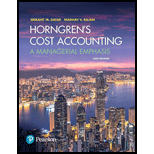
Concept explainers
Total factor productivity (continuation of 12-43). Refer to the data for Problem 12-43.
Assume the fabric costs $4.00 per yard In 2017 and $4.10 per yard in 2016.
- 1. Compute Gable Company’s total factor productivity (TFP) for 2017.
Required
- 2. Compare TFP for 2017 with a benchmark TFP for 2016 inputs based on 2017 prices and output.
- 3. What additional information does TFP provide that partial-productivity measures do not?
12-43 Partial-productivity measurement. Gable Company manufactures wallets from fabric. In 2016, Gable made 2,160,000 wallets using 1,600,000 yards of fabric. In 2016, Gable has capacity to make 2,448,000 wallets and incurs a cost of $8,568,000 for this capacity. In 2017, Gable plans to make 2,203,200 wallets, make fabric use more efficient, and reduce capacity.
Suppose that in 2017 Gable makes 2,203,200 wallets, uses 1,440,000 yards of fabric, and reduces capacity to 2,295,000 wallets at a cost of $7,803,000.
- 1. Calculate the partial-productivity ratios for materials and conversion (capacity costs) for 2017, and compare them to a benchmark for 2016 calculated based on 2017 output.
Required
- 2. How can Gable Company use the information from the partial-productivity calculations?
Trending nowThis is a popular solution!

Chapter 12 Solutions
REVEL for Horngren's Cost Accounting: A Managerial Emphasis -- Access Card (16th Edition) (What's New in Accounting)
- For each of the transactions above, indicate the amount of the adjusting entry on the elements of the balance sheet and income statement.Note: Enter negative amounts with a minus sign.arrow_forwardNeed help with this question solution general accountingarrow_forwardDon't use ai given answer accounting questionsarrow_forward
- I want to correct answer general accounting questionarrow_forwardKindly help me with accounting questionsarrow_forwardDuo Corporation is evaluating a project with the following cash flows: Year 0 1 2 3 Cash Flow -$ 30,000 12,200 14,900 16,800 4 5 13,900 -10,400 The company uses an interest rate of 8 percent on all of its projects. a. Calculate the MIRR of the project using the discounting approach. Note: Do not round intermediate calculations and enter your answer as a percent rounded to 2 decimal places, e.g., 32.16. b. Calculate the MIRR of the project using the reinvestment approach. Note: Do not round intermediate calculations and enter your answer as a percent rounded to 2 decimal places, e.g., 32.16. c. Calculate the MIRR of the project using the combination approach. Note: Do not round intermediate calculations and enter your answer as a percent rounded to 2 decimal places, e.g., 32.16. a. Discounting approach MIRR b. Reinvestment approach MIRR c. Combination approach MIRR % % %arrow_forward
- Principles of Accounting Volume 2AccountingISBN:9781947172609Author:OpenStaxPublisher:OpenStax College
